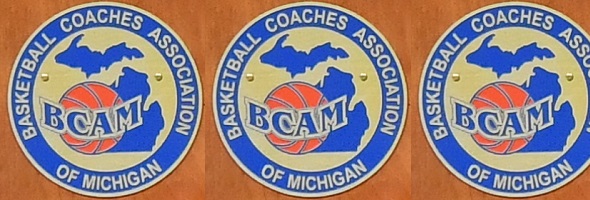
Final 'Retro' Mr Basketball Class Named
April 12, 2019
Special from Basketball Coaches Association of Michigan
With the completion of the 2018-19 prep basketball season, the Basketball Coaches Association of Michigan proudly wraps up its decade-long “Retro” Mr. Basketball project with the announcement of the final six honorees.
Over the course of 10 seasons, the project has examined the high school court careers of hundreds of the state’s finest. The list of 61 honorees, when combined with the winners of the current ‘Mr. Basketball’ Award, first presented following the 1980-81 prep season, totals 100. A contiguous list of Michigan’s ‘Best of the Best’ now dates back to 1920.
Noting the amazing pool of talented basketball players produced by the state over the years, past Basketball Coaches Association of Michigan Executive Director Tom Hursey and Michigan High School Athletic Association historian Ron Pesch hatched a plan to replicate the ‘Mr. Basketball’ concept, and apply it to the past. The goal was to name the top high school senior ballplayer for each of the 61 years between 1920 and 1980.
To do so, Pesch hit the archives, examined the data, gathered names and assembled biographies, then provided a ballot. BCAM assembled a committee representing all parts of Michigan to examine the information, narrow the field to the best-of-the-best, and then vote for a winner.
“All along, the idea was to focus solely on the high school playing careers of these individuals, just like the current award,” said Hursey. “The committee did its best to ignore what came later, and to name a Mr. Basketball selection for each year. Now, with the 10th and final round of selections, the project is complete.”
“Just like with the current award, there will always be debate on the selections,” said Pesch. “Dave DeBusschere or Chet Walker? L.C. Bowen or Richie Jordan? Bill Chmielewski or Pete Gent? That’s a good thing. These players should never be forgotten in the halls of their high schools and by basketball fans across the nation. Michigan has produced and continues to turn out amazing athletic talent, year in and year out. So often, folks only recall the recent past. The ‘Retro’ Mr. Basketball project focuses a spotlight on our history.”
That spotlight now shines on the award that captures the names. Following the 2013 presentation of the award, BCAM retired the original Mr. Basketball trophy. The award has since been repurposed to capture the names of the “Retro” Mr. Basketball winners. The trophy now stands on display in East Lansing as part of the Tom Izzo Hall of History at the Breslin Center.
1929 RETRO MR. BASKETBALL
LOUIS JAGNOW, JACKSON –
1929 FINALISTS
Forest Baldwin, Bridgman – Captain of the Class D champion. Although not of unusual size, Baldwin was considered as lightning fast and a deceptive dribbler with an uncanny shot. He scored 22 points in the team’s Quarterfinal victory over Grand Rapids Godwin.
Neil Ludwick, Grand Rapids Creston – Center and top player on the best Creston team to date. Despite a Quarterfinal loss in the Class A tournament, Ludwick was singled out and named to the all-tourney team in 1929. A mid-year graduate in 1930.
Lester Wamsley, Highland Park – A steady, smart cager, Wamsley was an All-City selection by both the Detroit Times and Detroit Free Press, and a United Press International All-Tournament selection. Praised as an outstanding guard, good on long shots.
1939 RETRO MR. BASKETBALL
GENE BROENE, GRAND RAPIDS CHRISTIAN
1939 FINALISTS
Chet Jurwiak, Kalamazoo St. Augustine – “The state’s standout high school basketball player under the basket. He invariably grabbed 80 percent of the balls off the back board during a game,” wrote the Detroit Times when selecting him for first-team all-state honors. “Jurwiak was all-state in football and lost none of his ability on the court.”
Earl Kelly, Flint Northern, 6-foot-3 – described by a veteran Saginaw Valley Conference official as the best player in the league. Scored 176 points in 20 games in leading Northern to its third Class A championship in the school’s 11-year history. A mid-year graduate in 1939-40.
Ed (Nowaczyk) Novak, Flint St. Mary – First team all-state according to both the Free Press and the Times. Scored 260 points as a senior and, with his twin brother Edwin, “helped St. Mary annex the Class C state crown. Through his height he controlled the ball off both backboards, besides tossing in baskets on a highly productive basis.”
Frank Sabo, Detroit Southwestern – “Sabo was considered by many coaches as the best passer in the (Detroit city) league,” said the Free Press. “An outstanding floorman,” added the Detroit Times when naming Sabo to its all-city team. “Superlative off the backboard, a good shot and, above all, a fine leader.” Later played at Wayne University.
1949 RETRO MR. BASKETBALL
KEN BURRELL, HAMTRAMCK, 6-FOOT-3, 182
1949 FINALISTS
Chuck Holloway, Detroit Northern, 5-foot-8 – “He’s an all-around star, outstanding in the clutch as exemplified in the (City League playoff) semifinal game against Central, where he led Northern in a rally to win. He topped the loop in scoring (14 point average), is fast and difficult to stop,” wrote the Times. “Despite his lack of height, was probably the most adept player in the (Detroit City) league. An uncanny shot, he led Northern into the finals of the (league) playoffs,” wrote the Free Press.
Harry Lauder, Ferndale, 5-foot-11, 155 – Spectacular scorer and all-around performer and the spark of his team. “Was ‘raved over’ by virtually everyone who saw him perform,” stated the Times, when selecting him for first-team all-state honors. Called by his coach, Roy Burkhart, “one of the smoothest all-around players I’ve ever seen. The kid also is loaded with basketball sense.” Later played freshman and varsity basketball at Michigan.
Lysle Smith, Port Huron, 5-foot-11, 155 – “Known as a ‘pressure’ player who also draws the evening’s toughest defensive assignment for his team. His 193 points this season were mostly on set shots from far out on the court,” wrote the Free Press, honoring Smith with first-team all-state accolades. Later played at Michigan, where he became the first cager from Port Huron to win a varsity letter.
Carl Tschirhart, Milan, 6-foot-0, 155 – An all-around athlete and key cog in Milan’s 1948 Class C title, Tschirhart “connected on 33 percent of his 288 shots from the floor” as Milan ran its win streak to 40 games straight, spanning two seasons, before falling in the Regionals of the 1949 tournament. Later played for Michigan Normal (now Eastern Michigan University).
1959 RETRO MR. BASKETBALL
DAVID GAINES, DETROIT NORTHEASTERN, 6-FOOT-0, 180
1959 FINALISTS
John Bandy, Pontiac Central, 6-foot-3, 160 – A jump shooting specialist. “Averaged 19 points a game during the regular season to take the individual scoring title in the strong Saginaw Valley League,” said the Detroit Times, including him on its Dream Team. “Was Pontiac’s second leading rebounder,” wrote the Free Press when naming him Class A first-team all-state. “He could score from any spot on the floor.” Played college ball at Western Michigan University.
Jim Ludwig, Sault Ste. Marie, 6-foot-5½, 185 – “Rewrote virtually all of Sault Ste. Marie High’s individual scoring records,” wrote George Maskin in the Times. “A four-year veteran on the Blue Devils, he tossed in more than 1,100 points … During the recent season he collected over 450 points (373 in regular season play) and had a superlative shooting mark of 46 percent. Jim also headed the Soo in rebounds.”
Art Oliver, Muskegon Heights, 6-foot-0, 162 – Clever, sharpshooting guard. Leading scorer for the Tigers, totaling 318 points over 18 games, and 21.5 points per game over the last half of the season before the Heights fell to Grand Rapids Central in Regional play. A first-team all-state selection by both the Free Press and Times.
Art Reid, Hamtramck, 6-foot-2, 186 – “A superior rebounder and jumper, (and tireless worker), averaged 22 points a game for Hamtramck,” said Hal Schram in the Free Press. “Deadly from the corners as well as in front of the basket,” added the Times. He scored 364 points including 44 of 67 from the free throw line.
Jim Tilmon, Grand Rapids Central, 5-foot-9, 170 – “’Tilmon is the best around here since Don Eaddy,” chronicled Eugene Gailmeier of the Grand Rapids Herald. “Although basically a guard, Tilmon rotated so swiftly from one position to another it was impossible to tell at times what job he actually held,” said the Times. Led the city league in scoring. His 27 points in the Regional Final snapped Muskegon Heights’ string of 17 tournament wins and helped place Central in the Quarterfinals for only the third time in postseason history.
1969 RETRO MR. BASKETBALL
ERNIE JOHNSON, GRAND RAPIDS OTTAWA HILLS, 6-FOOT-7, 190
1969 FINALISTS
Ken Brady, Flint Central, 6-foot-9, 220 – Best big man to come out of Flint in many years. “Despite his 220 pounds, Brady gets up and down a basketball court with the agility and speed of a dashman. (Coach Clif) Turner insists he is often more valuable for his defensive play than his point production,” said Hal Schram in a midseason article. Set a new city scoring mark with 521 points in 21 games while helping Central win the Valley conference title. United Press International ‘Player of the Year’ in Michigan.
Tom Marsh, Detroit Northern, 6-foot-1, 168 – “Possibly the best player in either the Detroit Catholic or public school league” said The Associated Press, Marsh “became Northern’s first player to top 1,000 points in three varsity seasons. He averaged 27 points a game and was a fine outside shooter.”
Tim Megge, Orchard Lake St. Mary, 6-foot-2, 175 – Averaged 25.4 points a game, including a school record 56 points in one game, preceded by a 51-point game. Hit 46 percent of his field goal attempts and 72 percent of his foul shots according to UPI. In 81 games during his four-year varsity career, Megge scored 1,612 points.
Bob Rhodin, Ypsilanti – 6-foot-3½, 170 – “Led Ypsilanti to a 22-1 record and a No. 1 rating in the final AP poll. Scored 360 points during the year for a 19 point average and was the team’s top rebounder, grabbing 227,” said the AP. “Coach Dick Ouellette calls him ‘the best all-around player I’ve ever had.’ Rhodin has tremendous hustle and is a great defensive ballplayer.”
Cal Tatum Muskegon, 6-foot-1, 170 – "For his size, I've never seen an athlete who is so proficient in so many phases of the game," said then-Muskegon coach Mike Murphy. A guard, Tatum averaged 22.4 points, 10 rebounds, five assists and four steals per game his senior year to earn first-team all-state honors. He graduated as the Big Reds' all-time leading scorer with 1,250 career points, and an average of 22.7 points per game as a senior.
1979 RETRO MR. BASKETBALL
JAY SMITH, MIO AuSABLE, 6-FOOT-5, 192
1979 FINALISTS
Tim Andree, Birmingham Brother Rice, 6-foot-10, 230 – The “best big man in the state,” wrote Hal Schram in the Free Press. Averaged 23 points and 17 rebounds per game.
James Koger, Saginaw, 6-foot-4, 190 – A 1,000-plus career scorer who averaged 19.7 points, 11 rebounds and shot 47 percent from the floor” said the AP. “He ran the Saginaw offense,” added the Free Press in its first-team all-state write-up. “When he wasn’t in the lineup, Saginaw was a very ordinary team.”
Melvin McLaughlin, Grand Rapids Creston, 6-foot-1, 170 – Considered the state’s top “pure shooter,” McLaughlin scored 1,577 points, a 25.4 average, in his three-year career at Creston. Exceeded the 35-point mark in a game on four occasions as a senior.
Evaristo Perez, Orchard Lake St. Mary, 6-foot-8, 210 – Despite being in the U.S. less than two years, the Dominican Republic native averaged 22 points and 15 rebounds while hitting 57 percent of his shots. “He’s a real competitor and a leader on the flow,” St. Mary coach Bob Shoemaker told the Free Press. “We do a lot of things on the court, and he picked them up right away.”
Derek Perry, River Rouge, 6-foot-6, 210 – Coach Lofton Greene told Hal Schram that Perry was “probably the finest offensive player he has ever coached.” Averaged more than 28 points per game and “an incredible field-goal shooting percentage of 64 percent” entering the postseason.
Erich Santifer, Ann Arbor Huron, 6-foot-5, 165. “He has been the most valuable player in the rugged South Central Conference two years in a row,” said the Lansing State Journal at tournament time. “He prefers to work inside, but can also produce from long range as well.” Santifer held a 22.3 points per game average headed into the tournament Regional Final against Lansing Eastern, then scored 36 points against the Quakers in the contest although Huron was eliminated. “He’s probably the finest player we saw all season,” said Lansing Eastern coach Paul Cook. Later excelled at Syracuse.
MICHIGAN’S MR. BASKETBALL AWARD
Players from 1981-Present were honored as part of the current BCAM/Detroit Free Press Hal Schram Mr. Basketball Award. Players from 1920-1980 were selected as part of BCAM’s decade-long “Retro” Mr. Basketball project, launched in 2010 and completed in 2019.
2019 Romeo Weems, New Haven (DePaul)
2018 Foster Loyer, Clarkston (Michigan State)
2017 Isaiah Livers, Kalamazoo Central (Michigan)
2016 Cassius Winston, University of Detroit Jesuit (Michigan State)
2015 Deyonta Davis, Muskegon (Michigan State)
2014 DeShawn Thrower, Muskegon (Stony Brook/Ferris State)
2013 Monte Morris, Flint Beecher (Iowa State)
2012 Matt Costello, Bay City Western (Michigan State)
2011 Dwaun Anderson, Suttons Bay (Wagner)
2010 Keith Appling, Detroit Pershing (Michigan State)
2009 Derrick Nix, Detroit Pershing (Michigan State)
2008 Brad Redford, Frankenmuth (Xavier)
2007 Corperryale Harris, Detroit Redford (Michigan)
2006 David Kool, Grand Rapids South Christian (Western Michigan)
2005 Wilson Chandler, Benton Harbor (DePaul)
2004 Drew Neitzel, Wyoming Park (Michigan State)
2003 Dion Harris, Detroit Redford (Michigan)
2002 Paul Davis, Rochester (Michigan State)
2001 Kelvin Torbert, Flint Northwestern (Michigan State)
2000 Marcus Taylor, Lansing Waverly (Michigan State)
1999 Jason Richardson, Saginaw Arthur Hill (Michigan State)
1998 Dane Fife, Clarkston (Indiana)
1997 Shane Battier, Detroit Country Day (Duke)
1996 Winfred Walton, Detroit Pershing (Fresno State)
1995 Robert Traylor, Detroit Murray-Wright (Michigan)
1994 Willie Mitchell, Detroit Pershing (Michigan/UAB)
1993 Jon Garavaglia, Southgate Aquinas (Michigan State)
1992 Kenyon Murray, Battle Creek Central (Iowa)
1991 Chris Webber, Detroit Country Day (Michigan)
1990 Anthony Miller, Benton Harbor (Michigan State)
1989 Michael Talley, Detroit Cooley (Michigan)
1988 Matt Steigenga, Grand Rapids South Christian (Michigan State)
1987 Mark Macon, Saginaw Buena Vista (Temple)
1986 Terry Mills, Romulus (Michigan)
1985 Glen Rice, Flint Northwestern (Michigan)
1984 Demetreus Gore, Detroit Chadsey (Pittsburgh)
1983 Antoine Joubert, Detroit Southwestern (Michigan)
1982 Robert Henderson, Lansing Eastern (Michigan)
1981 Sam Vincent, Lansing Eastern (Michigan State)
1980 Tim McCormick, Clarkston (Michigan)
1979 Jay Smith, Mio-AuSable (Bowling Green/Saginaw Valley)
1978 Trent Tucker, Flint Northwestern (Minnesota)
1977 Earvin “Magic” Johnson, Lansing Everett (Michigan State)
1976 Stuart House, Detroit Denby (Washington State)
1975 Bruce Flowers, Berkley (Notre Dame)
1974 Tony Smith, Saginaw (Nevada-Las Vegas)
1973 Tom LaGarde, Detroit Catholic Central (North Carolina)
1972 Larry Fogle, Detroit Cooley (Southern Louisiana/Canisius)
1971 Michael "Campy" Russell, Pontiac Central (Michigan)
1970 Rick Drewitz, Garden City West (Kentucky)
1969 Ernie Johnson, Grand Rapids Ottawa Hills (Michigan)
1968 Ralph Simpson, Detroit Pershing (Michigan State)
1967 Spencer Haywood, Detroit Pershing (University of Detroit)
1966 Rudy Tomjanovich, Hamtramck (Michigan)
1965 L.C. Bowen, Benton Harbor (Bradley)
1964 Willie Betts, River Rouge (Bradley)
1963 Craig Dill, Saginaw Arthur Hill (Michigan)
1962 Ernie Thompson, Saginaw (Bradley)
1961 Reggie Harding, Detroit Eastern
1960 Peter Gent, Bangor (Michigan State)
1959 David Gaines, Detroit Northeastern (LeMoyne, now LeMoyne-Owens)
1958 Chet Walker, Benton Harbor (Bradley)
1957 Ed Burton (Michigan State)
1956 Mel Peterson, Stephenson (Wheaton)
1955 M.C. Burton, Jr., Muskegon Heights (Michigan)
1954 Pete Tillotson, Ludington (Michigan)
1953 Ron Kramer, East Detroit (Michigan)
1952 Frank Tanana, Sr., Detroit St. Andrew, (Cal State-Fullerton – baseball)
1951 Webster Kirksey, Saginaw (Eastern Michigan)
1950 Charlie Primas, Detroit Miller (Wayne State)
1949 Ken Burrell, Hamtramck (Lawrence Tech)
1948 Art McColgan, Saginaw SS Peter & Paul (Villanova)
1947 Sammy Gee, Detroit Miller
1946 Jack Forestieri, Benton Harbor (Notre Dame)
1945 Bob Swanson, Lansing Sexton (Michigan)
1944 Dick Rifenburg, Saginaw Arthur Hill (Michigan)
1943 Don Boven, Kalamazoo Central (Western Michigan)
1942 Larry Savage, Saginaw (Northwestern)
1941 Don Osterman, Detroit St. Theresa (Villanova)
1940 Ralph Gibert, Flint Northern (Michigan)
1939 Gene Broene, Grand Rapids Christian (Calvin College)
1938 John Maartens, Kalamazoo Central
1937 Bob Osterman, Detroit St. Theresa (Notre Dame)
1936 Charles Pink, Detroit Northwestern (Michigan)
1935 John Zwier, Holland Christian
1934 Earl Brown, Jr., Benton Harbor (Notre Dame)
1933 Lincoln Dodson Truss, Flint Northern
1932 Lowell Matteson, Portage
1931 Edward Huttenga, Grand Haven (Western Michigan)
1930 John Tooker, Kalamazoo St. Augustine (Michigan)
1929 Louis Jagnow, Jackson (Carnegie Tech)
1928 Francis Doolittle, Detroit Northwestern
1927 Bill McCall, Muskegon (Dartmouth)
1926 Roger Grove, Sturgis (Michigan State)
1925 Joe Truskowski, Detroit Northeastern (Michigan)
1924 Bennie Oosterbaan, Muskegon (Michigan)
1923 Henry Schrumpf, Niles (Western Michigan)
1922 Royal Cherry, Grand Rapids Union (Michigan)
1921 George Haggarty, Ypsilanti (Michigan)
1920 Harry Kipke, Lansing Central (Michigan)
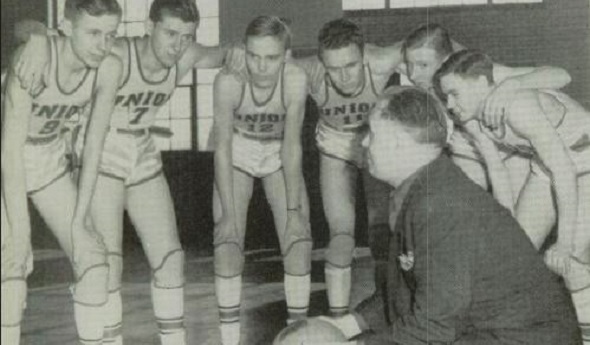
The Last Time MHSAA Finals were Canceled
By
Ron Pesch
MHSAA historian
April 27, 2020
Historians trace the start of World War II to German dictator Adolph Hitler’s decision to invade Poland on September 1, 1939. The Empire of Japan’s involvement in the war became effective in September 1940 with the signing of the Tripartite Pact.
Until December 7, 1941, the United States avoided official involvement, declaring themselves “a neutral nation.” Then came Imperial Japan’s bombing of Pearl Harbor.
A labor shortage caused by World War I had taken out spring high school sports in Michigan in 1917. As noted in the Second Half article, “1918 Pandemic, WWI Threatened High School Sports,” the global spread of a devastating strain of influenza interrupted the football season in Michigan. Prep athletics would roar through the 1920s and survive the Great Depression before seeing another interruption.
That next disturbance had nothing to do with war’s insatiable desire for manpower. Rather, it was because of tires.
“When the Japanese bombed Pearl Harbor, rubber instantly became the most critical strategic material for making war,” wrote Stephen W. Sears in the October/November issue of American Heritage magazine in 1979. “Nine-tenths of the nation’s rubber came from the Far East, and it was painfully evident that nothing would now stop Japan from cutting off that source.”
Americans consumed nearly two-thirds of the world’s production of rubber. With only about a year’s worth of material on hand, “Just four days after Pearl Harbor a freeze was put on the sale of new passenger-car tires,” stated Sears, “and on December 27 tire rationing was authorized, to go into effect early in January, 1942. Sales of new cars also were halted.”
The MHSAA
The Michigan High School Athletic Association arrived in December 1924. It replaced the old Michigan Interscholastic Athletic Association which had served Michigan for 15 years.
The organization’s primary purpose was to standardize, interpret and administer rules, educate and guide officials, and regulate student eligibility within prep sports in Michigan. By the 1940s, it had evolved into an association that also managed postseason tournaments, designed to identify state champions in specific sports: swimming, cross country, golf, tennis, track, and the sport sponsored by the most high schools in the state, basketball.
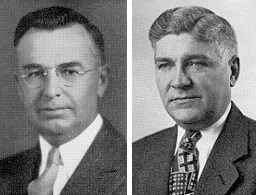 “The old MIAA had taken over the regulation of basketball tournaments in 1920. This had been done as a service to the schools and especially as a means of eliminating evils inherent in the invitational tournaments (that were hosted by various colleges around the state and the midwest),” wrote Lewis L. Forsythe in his book, Athletics in Michigan High Schools, recalling the first 100 years of prep sports in the state.
“The old MIAA had taken over the regulation of basketball tournaments in 1920. This had been done as a service to the schools and especially as a means of eliminating evils inherent in the invitational tournaments (that were hosted by various colleges around the state and the midwest),” wrote Lewis L. Forsythe in his book, Athletics in Michigan High Schools, recalling the first 100 years of prep sports in the state.
“In the last days of February 1942,” multiple Michigan schoolmen were in San Francisco to attend the annual meetings of Secondary School Principals, Superintendents and the National Federation of State High School Associations. “We were well aware that many of our boys in school would have to offer themselves in the service of their country,” noted Forsythe in his publication. “We fully realized that the quality of that service and, indeed, their own survival might well depend quite as much on their physical fitness as on their intellectual and spiritual resources. It was under those circumstances that we determined so to modify the emphasis of our athletic program as to make the largest possible contribution to the war effort. We recognized that the need in Michigan could not be met by our organization alone, and we therefore determined to encourage a general enrollment of all school groups in a united effort for promotion of physical fitness.”
Because of the “scarcity of tires and automobiles,” in April 1942 the MHSAA announced plans to curtail their upcoming annual golf and tennis events, eliminating a state championship round. Instead, the seasons were concluded with separate eastern and western sectional tournaments, hosted in Ann Arbor and Grand Rapids.
Early in May of 1942, MHSAA executive director Charlie Forsythe, nephew of Louis Forsythe, announced that the Association was “working on plans designed to make body-building exercises available to more young men and to spread recognition of sports achievements. He predicted substantial growth of intramural sports to include youngsters whose limited prowess might keep them from such interscholastic sports as football, baseball or basketball.”
Wire articles had told the story of how the running Battle of the Atlantic had impacted U.S. ocean transportation along the eastern seaboard. A Germany-mounted “campaign against American coastal shipping” by U-boats (submarines) was devastating “a section of America almost exclusively dependent upon ocean-point tankers for its petroleum products.” Without a viable alternative means to transport the products, on May 15, 1942, gasoline rationing began in 17 seaside states and the District of Columbia. It was hinted that gas rationing – specifically designed to save rubber – could roll out nationally. (Crude oil is the main ingredient in man-made rubber.)
The chances for restrictions in Michigan were a distinct possibility. According to P.J. Hoffmaster, the state’s supervisor of wells, the state consumed approximately 140,000 barrels of oil per day, but produced only 64,054 barrels. “This state has a shortage of at least 100,000 barrels on the basis of a regional demand,” he said, noting Michigan oil also supported needs outside the state. “When people say there can’t be rationing in Michigan because we have plenty of our own oil, they don’t have the true picture.”
Reverberations begin
When quizzed on the subject before the annual Lower Peninsula Track and Field championships, hosted at Michigan State College in May 1942, (Charlie) Forsythe, told The Associated Press he was unsure how rationing might affect the Association’s annual playoffs.
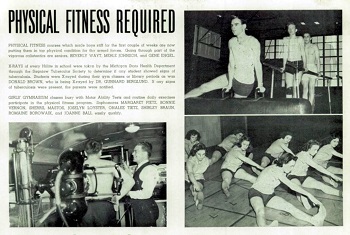 “It is too early as yet to say exactly. … We are making every effort to maintain an adequate athletic program. Certainly where common carriers (busses and trains) will make it possible to get a team to a game, that means should be used,” Forsythe said. He added that the Association was “surprised to find the number of schools competing in this year’s tournaments practically equaled last year’s entries.”
“It is too early as yet to say exactly. … We are making every effort to maintain an adequate athletic program. Certainly where common carriers (busses and trains) will make it possible to get a team to a game, that means should be used,” Forsythe said. He added that the Association was “surprised to find the number of schools competing in this year’s tournaments practically equaled last year’s entries.”
A total of 162 schools had qualified individual contestants in the track championships, about 10 percent fewer than in 1941. However, L.L. Frimodig – the assistant director of college athletics at M.S.C. and acting director of the state track meet – felt “the actual field in the four-class carnival would be much smaller than the number eligible to compete,” considering the circumstances of travel. “Many coaches,” he said, “would think in terms of tires rather than trophies before embarking on any sizable journey to the meet.”
The threat of rationing was almost immediately seen within Michigan’s resorts and travel industry.
“July and August have been moved up into June,” wrote the Detroit Free Press. “This is the word that comes from various parts of the state. Evidently, determination to get the vacation over before gas rationing may be decreed is one of the factors that has stepped up the season. … Reports of heavy patronage at nearby resorts over Memorial Day week-end can be taken as an indication of the trend, or necessity in 1942 of holidays enjoyed close to home base.”
Come September, Joseph B. Eastman, national director of the office of war transportation, called for help in reducing consumption of natural resources: “We intend to solicit the help of colleges and universities in making arrangements for transfer of scheduled games to centers of population where as many people as possible will have an opportunity to attend football games without traveling.”
At the college level, the freshman eligibility rule was waived due to the loss of manpower tied to military enlistment and the enactment of the Selective Training and Service Act of 1940. Its passage required all men between ages 21 and 45 to register for the first peacetime draft in U.S. history. With entry into the war, in December 1941, it was amended to require all 18 to 64-year-olds to register, with starting age for likely draft lowered to 20.
“The seasons of 1942-45 turned the (college) game upside down, creating new juggernauts and decimating some old ones,” wrote Sports Illustrated in its 1971 article, “When Football Went to War.”
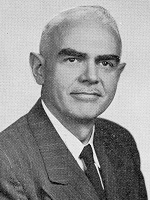 “Michigan’s 85 high school athletic leagues are speculating on the effects of the office of defense transportation plan to whittle sports travel drastically,” stated an Associated Press (AP) article soon after Eastman’s announcement. The Southwestern Conference, comprised of Kalamazoo Central, Benton Harbor, Muskegon, Holland, Grand Haven and Muskegon Heights and one of the most widely spread major prep circuits in the state, was told by its regular bus company that its busses were not available for charter.
“Michigan’s 85 high school athletic leagues are speculating on the effects of the office of defense transportation plan to whittle sports travel drastically,” stated an Associated Press (AP) article soon after Eastman’s announcement. The Southwestern Conference, comprised of Kalamazoo Central, Benton Harbor, Muskegon, Holland, Grand Haven and Muskegon Heights and one of the most widely spread major prep circuits in the state, was told by its regular bus company that its busses were not available for charter.
On Sept. 25, according to AP, “the state department of public instruction warned today that a threat of ‘no new tires’ will be held over rural schools which use their school busses to transport football players to and from games.”
Julian W. Smith, named the interim director of the MHSAA when Charlie Forsythe went into military service, didn’t think the directive would have much impact on football schedules. “However, I believe the order will have a serious effect on basketball schedules this winter and on next year’s football schedule.”
“Four Gallons a Week for Most Drivers”
Two days later it was announced that nationwide gas rationing would go into effect at the beginning of December 1942. More immediately, compulsory tire inspections every 60 days and a “Victory Speed Limit” of 35 miles per hour, effective Oct. 1, were also enacted. “This is not a gasoline rationing program, but a rubber conservation program,” said William M. Jeffers, president of the Union Pacific Railroad, which had been placed in charge of the government’s struggle to alleviate the rubber shortage.
“The object is not to take cars off the road, but to keep them on the road. … The safe life of a tire at 50 miles per hour is only half as great as it is at 30 m.p.h.”
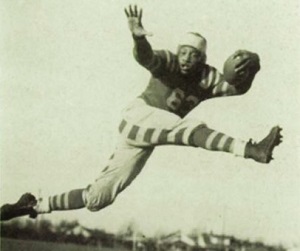 After initial announcements of game cancellations, the impact on high school football in Michigan in 1942 appears to have been minimal. Solutions were found to most challenges. In Bessemer, the high school superintendent announced that “enough persons have volunteered their automobiles to take the Speed Boy players to Calumet” for the game, scheduled for Saturday, Oct. 3. At season’s end, Flint Northern, Detroit Catholic Central, Muskegon, and Wyandotte each lay claim to a share of Michigan’s mythical football title.
After initial announcements of game cancellations, the impact on high school football in Michigan in 1942 appears to have been minimal. Solutions were found to most challenges. In Bessemer, the high school superintendent announced that “enough persons have volunteered their automobiles to take the Speed Boy players to Calumet” for the game, scheduled for Saturday, Oct. 3. At season’s end, Flint Northern, Detroit Catholic Central, Muskegon, and Wyandotte each lay claim to a share of Michigan’s mythical football title.
But a hint of what was to follow came with an announcement concerning the annual Cross Country Finals. The state meet was cancelled to reduce travel, with honors instead awarded during October meets to which schools were assigned based on geography.
In its October 1942 bulletin, the MHSAA endorsed a commando-type “training plan drafted by the Minnesota branch of the office of civilian defense” to “step up scholastic physical fitness programs.” When plotted on a football field, the course bordered the playing area with 11 obstacles spaced 20 yards apart. The course required participants to jump a 4-foot fence, crawl under a 2-foot-high rope, then run between a maze of stakes and, later in the course, high-step through a series of open boxes. Students would scale a 7½-foot wall, walk on a 12-foot balance beam, swing across a broad jump pit from a rope that hung from above, then climb another rope hung from the crossbar of the goal posts. Once accomplished, the participant was to move, hand-over-hand, across the span of the crossbar before dropping to the ground.
At the end of October, the MHSAA’s Representative Council acknowledged the direct contribution that interscholastic sports had on the “lives of students and citizens of the communities in which they are offered” while recommending that they be “retained insofar as possible.”
The committee, however, also emphasized its belief “that physical fitness programs for all students, and intramural sports to offer opportunity for competition to all, should be stressed in the schools’ athletics program.
“In all probability,” it continued, “it will be necessary to modify the general plans of conducting tournaments.” The mechanics of modification would be hammered out at the next Council meeting to be held in December in Lansing.
Financial concerns also were expressed, as much of the Association’s operating budget came from a share of gate receipts of tournaments.
The Impact
“All over the state, athletic directors and coaches are tackling transportation problems. Instead of piling the athletes into privately owned automobiles or school busses, coaches have diligently studied timetables of regular train and bus lines with many satisfactory results,” stated the AP on Dec. 4.
That same day, the MHSAA announced that the upcoming basketball postseason would be altered due to rationing. The story was picked up by various newspapers across the Midwest.
“The association’s Representative Council last night stressed need for following a ‘principle of minimum travel’ in basketball play this winter and voted to dispense with the annual Lower Peninsula finals,” instead opting for a modified layout. Initial conversation related to a plan calling for sectional meets with the possibility of naming titles in the northern half of the Lower Peninsula, and in both the southern and eastern areas. An appointed basketball committee was also to consider combining enrollment classifications wherever necessary to localize tournament play.
From 1932-1947, inclusive, separate Lower and Upper Peninsula basketball champions were determined. The Upper Peninsula Athletic Committee announced a similar plan at its meeting in January of 1943. The committee expected to present winners of the U.P. events with certificates instead of the customary trophies due to shortage of materials prompted by the war.
According to a survey of its 40 member state associations by the National Federation of State High School Associations, Michigan was one of only four states, including Maine, Montana and Nevada, to eliminate naming basketball state champions come the winter of 1943, “since the distances within those states are too vast or transportation facilities are too limited. The same will prevail in track contests.”
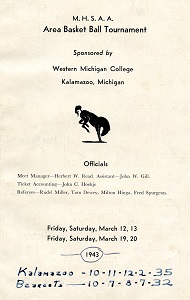 By mid-January, the MHSAA had polled its membership, and approximately 95 percent of the state’s high schools indicated a desire to participate in the replacement tournaments pitched by the Association. After examining the logistics, the plan previously discussed was modified. The Association then identified 51 Lower and 11 Upper Peninsula sites, based on availability to host the tournament and geographic suitability. The competition would run for two weeks, and end with what had previously equaled District championship contests.
By mid-January, the MHSAA had polled its membership, and approximately 95 percent of the state’s high schools indicated a desire to participate in the replacement tournaments pitched by the Association. After examining the logistics, the plan previously discussed was modified. The Association then identified 51 Lower and 11 Upper Peninsula sites, based on availability to host the tournament and geographic suitability. The competition would run for two weeks, and end with what had previously equaled District championship contests.
In the meantime, the annual swim championships were reduced to a one-day meet. Hosted at the University of Michigan, the meet would tax the endurance of individual swimmers, “since officials … decided to conduct semi-final events additional to the customary qualifying trials and finals.” That meant a swimmer entered in two events could compete six times during the day, with qualifying events in the morning, semifinals in the afternoon and finals swum at night. Perennial powers Battle Creek Central and Ann Arbor University High emerged as champions.
“The war to date has proved one thing conclusively – athletics in all schools must go on, for they serve to properly condition our young men for the bigger task ahead,” said MHSAA interim director Smith, speaking at an “annual football and basketball ‘bust’ for Lakeview High School” in Battle Creek in February 1943. Smith had served as principal at the high school for 14 years before taking over at the MHSAA. He “expressed regret” that the MHSAA had altered the various formats of the annual championships. According to coverage of the gathering in the Battle Creek Enquirer, “he intimated that it, along with all other forms of statewide competition, would be restored before another school year begins.”
Continued Chaos
The cities of Lansing and Kalamazoo played host to the most contingents, with 25 teams across the four enrollment classifications playing games at recently completed Lansing Sexton – the rechristened Lansing Central High School – and the Lansing Boys Vocational School. A total of 23 schools squared off at Western Michigan College of Education (now Western Michigan University).
As previously stated, transportation considerations meant some schools played above or below their normal classification to make things work. Ecorse, normally a Class B school, battled in the Class A tournament hosted at Dearborn Fordson. Benton Harbor, with Class A enrollment numbers, competed in the Class B tournament played across the St. Joseph River at St. Joseph High School instead of at the Kalamazoo Area tournament against similarly-sized schools.
A total of 128 area titles were awarded across the state’s two peninsulas. Decatur, the Class C state champion in 1942 with a 25-0 record, was the only team titlist to repeat in 1943, emerging with one of the “Area” crowns and extending its streak of victories to 41 consecutive. Also among the winners was Grand Rapids Union, a “cellar team in the regular season.”
“Although Union stood seventh in the city tally, the Red Hawks won the Area Tournament Crown in three smashing, spine-tingling battles,” stated the sports editor in the 1943 Aurora - Union’s yearbook. “In fast games the Hawks overcame Catholic and beat the Creston Bears … as well as whipping Davis Tech for their final victory.”
In April, the MHSAA confirmed that competition would end with area, city or conference meets in track, and again in tennis and golf, because of transportation, participation issues, and the “prospects of closing of some of the schools early.”
Various fans and media members grumbled about the unsatisfying conclusion to the prep sports calendars.
Hope
The coaching ranks were heavily hit by the war, as numerous mentors were tapped by the armed forces to lead physical fitness programs. Despite initial concerns, few “of the state’s 400 football-playing prep schools” dropped the sport come the 1943-44 school year. As it would turn out, because of the travel constraints, attendance increased as more and more sports fans turned to high school competition for entertainment.
Smith stated in October that he had “yet to find anyone who is definitely against bringing the (basketball) championship tournament back to life. There seems to be overwhelming sentiment in favor of the revival. The schools right-about face on the state cage classic which annually drew 700 prep teams and 11,000 players is explained by the fact coaches now feel the federal government is strongly in favor of any attempt to encourage or extend athletics. Last year schoolmen were not certain what the government’s attitude on sports would be and were hesitant about continuing athletics in pre-war style.”
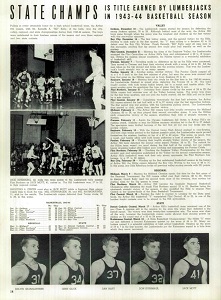 Only 258 of 614 schools replied to a questionnaire about restoring the winter basketball state championships, but 73 percent of respondents were in favor of such, and in December, the Representative Council voted to resume the final rounds of the tournaments.
Only 258 of 614 schools replied to a questionnaire about restoring the winter basketball state championships, but 73 percent of respondents were in favor of such, and in December, the Representative Council voted to resume the final rounds of the tournaments.
Born October 1918 in St. Johns, Michigan at the peak of the “Spanish Flu” pandemic, Hal Schram was a 25-year-old sports reporter for the Lansing State Journal when he covered the restart.
“State championship basketball and track competition once more became a part of (the) Michigan high school athletic program when the Representative Council of the MHSAA voted to reinstate these two state-wide tournaments after a suspension of one year,” he wrote.
According to Schram, “It was believed that student working hours, transportation, scarcity of balls and general lack of interest” still necessitated cancellation of golf and tennis tournaments for the year. Conduction of a swimming championship was left “in the hands of a committee representing schools which sponsor the sport … subject to the approval of the representative committee.”
Plans were to return the final rounds of the basketball tournament to Jenison Field House on the campus of Michigan State, which had hosted those rounds from 1940-42. However, the facility was in use by Army trainees for a physical fitness program.
“We would like to have the finals staged here very much,” said MSC athletic director Ralph Young, “but our obligations to the army come first.”
“Despite the hitch, the executive committee opted to stay in Lansing, playing Class A and C semifinal contests at the Boys Vocational School fieldhouse, and Class B and D semi games at Sexton High School. Finals were held at the Vocational gym.
“Fifty-five hundred spectators jammed their way into every nook and cranny of the Boys Vocational school fieldhouse last night to see four high school teams (Saginaw Arthur Hill, Marshall, Lansing St. Mary, Benton Harbor St. John) win championships in the Lower Peninsula tournament finals. With all seats taken almost before the first game started, the big floor was completely encircled by people sitting and standing before the finish,” wrote State Journal sports editor George S. Alderton. “By 6 o’clock, when the Class D game started, all seats in the side bleachers had been filled and most of the end bleachers were gone. The last vacancy was occupied before the Class C game started at 7:15 o’clock and from that time on, those who came either stood or seized a seat left by some departing fan. In many instances two sat down when one departed. Corners of the court were seething masses of humanity …”
United Press International wire reports indicated that 8,500 in total saw the Finals, as fans shifted in and out of the venue in support of the participating teams. “Some people had to be turned away at the finals,” said Smith, “and that certainly shows that people need and want this kind of relaxation.” The previous three Finals at MSC had drawn between 6,000-7,000 fans, while the 1939 Finals at I.M.A in Flint drew 5,000 and the 1938 event at Grand Rapids Civic Auditorium saw 6,000 attend.
“Lighting was so poor in the press box Friday night for the semi-finals,” added Alderton, “that workers came equipped with candles for the finals on Saturday night and propped them against their typewriters.”
Ishpeming hosted the Upper Peninsula Finals, as Escanaba, Crystal Falls, Channing and Amasa swept titles, respectively, in Classes B, C, D and Class E – the state’s smallest classification, reserved only for the smallest U.P. schools based on enrollment.
“Only complaint,” noted the Marquette Mining Journal, “was from those who couldn’t get in or were caught in a jam of fans seeking general admission seats. … Probably another 100 to 200 could have been accommodated if they were permitted to sit on the floor all along the court lines, but this would have been hazardous to players and fans …”
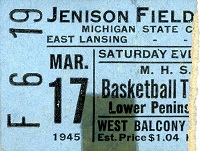 (The Lower Peninsula finals returned to Jenison in 1945 – where they stayed, uninterrupted, through 1970 – and were played before 7,833 spectators that first season back. Locals were delighted as they watched Lansing Sexton top Benton Harbor’s undefeated Tigers, 31-30. Michigan Governor Harry Kelly “personally presented the Class B championship trophy to Sturgis Capt. Tom Tobar, congratulated Capt. Larry Thomson of East Lansing and then shook hands with the captains of the Class A contest before the game started.”)
(The Lower Peninsula finals returned to Jenison in 1945 – where they stayed, uninterrupted, through 1970 – and were played before 7,833 spectators that first season back. Locals were delighted as they watched Lansing Sexton top Benton Harbor’s undefeated Tigers, 31-30. Michigan Governor Harry Kelly “personally presented the Class B championship trophy to Sturgis Capt. Tom Tobar, congratulated Capt. Larry Thomson of East Lansing and then shook hands with the captains of the Class A contest before the game started.”)
In mid-May, “some 800 Michigan prep trackmen, survivors of 40 regionals at 10 centers” headed to Michigan State College to determine statewide champs. Only Kalamazoo in Class A and Birmingham in Class B held the chance to “repeat” as team champions. Instead, Saginaw Arthur Hill capped a stellar sports year, earning its first Class A team track title to go with its recently-earned basketball crown. (Earlier in the school year, the Lumberjacks also had opened their own football field.)
East Grand Rapids earned its second track title, grabbing the Class B crown. Fowlerville and Glen Arbor Leelanau brought home titles in Class C and D, respectively.
All sports – including golf and tennis which had gone three years without competing in a true state title round – returned to their original formats with the start of the 1944-45 school year.
In May 1945, Germany surrendered to the Allies, followed by Imperial Japan’s surrender, announced in August.
Participation in prep sports and attendance numbers would explode across the state and the nation in the coming years, tied to multiple factors, including, of course, the baby boom that followed World War II.
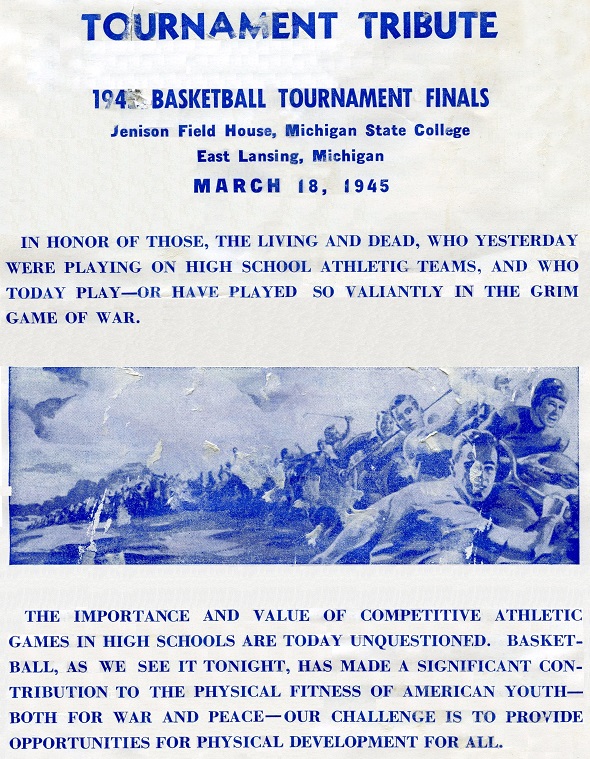
 Ron Pesch has taken an active role in researching the history of MHSAA events since 1985 and began writing for MHSAA Finals programs in 1986, adding additional features and "flashbacks" in 1992. He inherited the title of MHSAA historian from the late Dick Kishpaugh following the 1993-94 school year, and resides in Muskegon. Contact him at [email protected] with ideas for historical articles.
Ron Pesch has taken an active role in researching the history of MHSAA events since 1985 and began writing for MHSAA Finals programs in 1986, adding additional features and "flashbacks" in 1992. He inherited the title of MHSAA historian from the late Dick Kishpaugh following the 1993-94 school year, and resides in Muskegon. Contact him at [email protected] with ideas for historical articles.
PHOTOS: (Top) Grand Rapids Union was among "Area" boys basketball champions in 1943. (2) Lewis Forsythe, left, and Charles Forsythe were among leaders during the MHSAA's first decades (3) The Saginaw Arthur Hill yearbook for 1944 tells of fitness training undertaken by students. (4) Julian W. Smith served as interim MHSAA executive director while Charles Forsythe was serving in the military. (5) Flint Northern's Bill Hamilton earned all-state honors in 1942. (6) Western Michigan College was among hosts of 1943 Area tournaments. (7) Arthur Hill's yearbook celebrates the 1943-44 boys basketball championship. (8) Basketball Finals returned to Jenison Field House in 1945. (9) The MHSAA paid tribute to World War II veterans in its 1945 Basketball Finals program.

